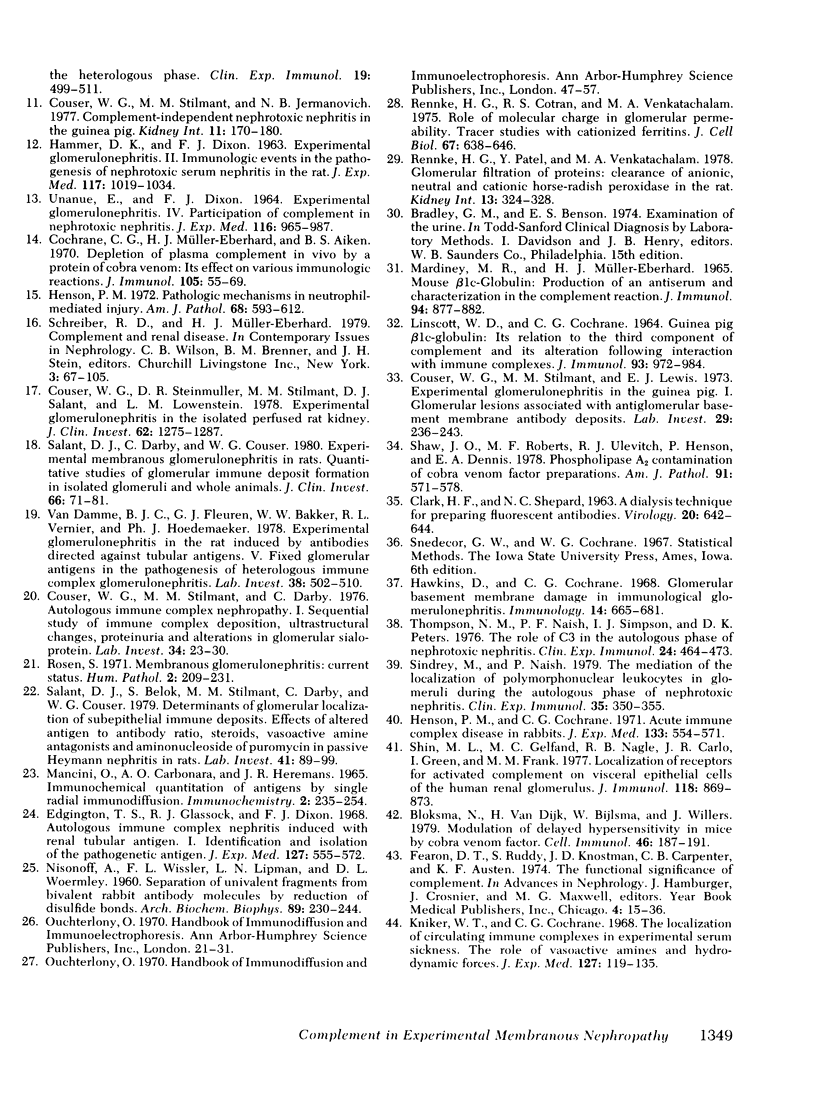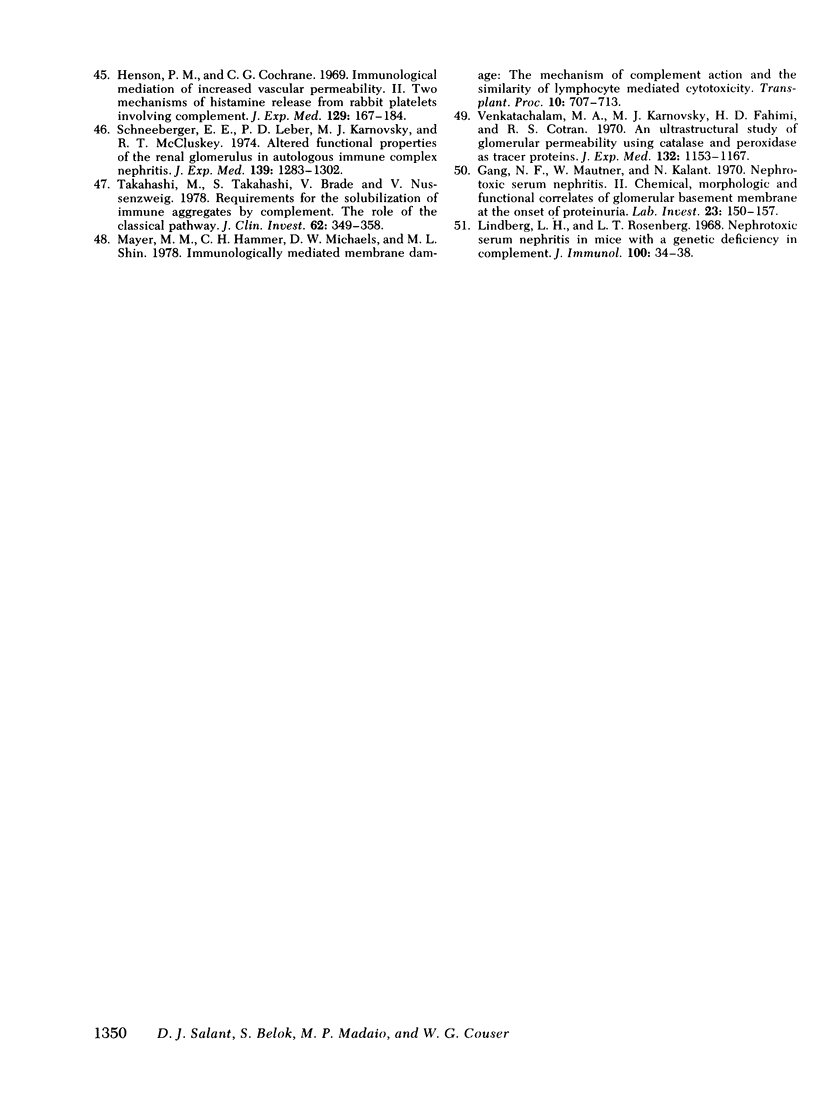Abstract
The only established role for complement in mediating immunologic renal disease involves elaboration of leukochemotactic factors and neutrophil-dependent glomerular injury. In the passive Heymann nephritis (PHN) model of experimental membranous nephropathy, rats injected with sheep antibody to rat proximal tubular brush border antigen (Fx1A) form subepithelial deposits of sheep IgG and rat complement (C3), and develop heavy proteinuria after 5 d without glomerular inflammatory changes. To study the role of complement in mediating proteinuria in PHN, 16 rats were treated daily with cobra venom factor from before antibody injection to maintain C3 levels at < 10% of pretreatment values and compared to 16 untreated controls. Proteinuria at 5 d was abolished in C3-depleted rats (4 +/- 1, controls 70 +/- 15 mg/d, P < 0.001), although renal deposition of 125I-labeled antibody ws the same in both groups (188 +/- 35 vs. 191 +/- 22 microgram IgG/2 kidneys, P > 0.5). Nephritogenic doses of both the noncomplement-fixing F(ab')2 portion and the gamma 2 subclass of anti-Fx1A IgG produced subepithelial deposits of immunoglobulin without C3, but proteinuria did not occur despite glomerular deposition of up to 70 microgram/2 kidneys of gamma 2. However, glomerular deposition of as little as 60 microgram of gamma 1 produced C3 fixation in vivo and heavy proteinuria. No neutrophil exudate could be detected histologically in PHN from the time of antibody injection through development of proteinuria. Proteinuria in five PHN rats depleted of neutrophils to < 200/mm3 with antineutrophil serum was not reduced compared to six controls with normal neutrophil counts (34 +/- 9.6 vs. 25 +/- 10.4 mg/d, P > 0.5). These results demonstrate that proteinuria in the PHN model of membranous nephropathy is complement-dependent and strongly suggest a neutrophil-independent mechanism. Thus a new role for the complement system in mediating immunologic glomerular injury is identified.
Full text
PDF











Images in this article
Selected References
These references are in PubMed. This may not be the complete list of references from this article.
- Bloksma N., van Dijk H., Bijlsma W., Willers J. Modulation of delayed hypersensitivity in mice by cobra venom factor. Cell Immunol. 1979 Aug;46(1):187–191. doi: 10.1016/0008-8749(79)90257-0. [DOI] [PubMed] [Google Scholar]
- CLARK H. F., SHEPARD C. C. A DIALYSIS TECHNIQUE FOR PREPARING FLUORESCENT ANTIBODY. Virology. 1963 Aug;20:642–644. doi: 10.1016/0042-6822(63)90292-7. [DOI] [PubMed] [Google Scholar]
- COCHRANE C. G., UNANUE E. R., DIXON F. J. A ROLE OF POLYMORPHONUCLEAR LEUKOCYTES AND COMPLEMENT IN NEPHROTOXIC NEPHRITIS. J Exp Med. 1965 Jul 1;122:99–116. doi: 10.1084/jem.122.1.99. [DOI] [PMC free article] [PubMed] [Google Scholar]
- Cochrane C. G. Mediation of immunologic glomerular injury. Transplant Proc. 1969 Dec;1(4):949–958. [PubMed] [Google Scholar]
- Cochrane C. G., Müller-Eberhard H. J., Aikin B. S. Depletion of plasma complement in vivo by a protein of cobra venom: its effect on various immunologic reactions. J Immunol. 1970 Jul;105(1):55–69. [PubMed] [Google Scholar]
- Couser W. G., Salant D. J. In situ immune complex formation and glomerular injury. Kidney Int. 1980 Jan;17(1):1–13. doi: 10.1038/ki.1980.1. [DOI] [PubMed] [Google Scholar]
- Couser W. G., Steinmuller D. R., Stilmant M. M., Salant D. J., Lowenstein L. M. Experimental glomerulonephritis in the isolated perfused rat kidney. J Clin Invest. 1978 Dec;62(6):1275–1287. doi: 10.1172/JCI109248. [DOI] [PMC free article] [PubMed] [Google Scholar]
- Couser W. G., Stilmant M. M., Darby C. Autologous immune complex nephropathy. I. Sequential study of immune complex deposition, ultrastructural changes, proteinuria, and alterations in glomerular sialoprotein. Lab Invest. 1976 Jan;34(1):23–30. [PubMed] [Google Scholar]
- Couser W. G., Stilmant M. M., Jermanovich N. B. Complement-independent nephrotoxic nephritis in the guinea pig. Kidney Int. 1977 Mar;11(3):170–180. doi: 10.1038/ki.1977.25. [DOI] [PubMed] [Google Scholar]
- Couser W. G., Stilmant M., Lewis E. J. Experimental glomerulonephritis in the guinea pig. I. Glomerular lesions associated with antiglomerular basement membrane antibody deposits. Lab Invest. 1973 Aug;29(2):236–243. [PubMed] [Google Scholar]
- Edgington T. S., Glassock R. J., Dixon F. J. Autologous immune complex nephritis induced with renal tubular antigen. I. Identification and isolation of the pathogenetic antigen. J Exp Med. 1968 Mar 1;127(3):555–572. doi: 10.1084/jem.127.3.555. [DOI] [PMC free article] [PubMed] [Google Scholar]
- Gang N. F., Mautner W., Kalant N. Nephrotoxic serum nephritis. II. Chemical, morphologic, and functional correlates of glomerular basement membrane at the onset of proteinuria. Lab Invest. 1970 Aug;23(2):150–157. [PubMed] [Google Scholar]
- HAMMER D. K., DIXON F. J. Experimental glomerulonephritis. II. Immunologic events in the pathogenesis of nephrotoxic serum nephritis in the rat. J Exp Med. 1963 Jun 1;117:1019–1034. doi: 10.1084/jem.117.6.1019. [DOI] [PMC free article] [PubMed] [Google Scholar]
- Hawkins D., Cochrane C. G. Glomerular basement membrane damage in immunological glomerulonephritis. Immunology. 1968 May;14(5):665–681. [PMC free article] [PubMed] [Google Scholar]
- Henson P. M., Cochrane C. G. Acute immune complex disease in rabbits. The role of complement and of a leukocyte-dependent release of vasoactive amines from platelets. J Exp Med. 1971 Mar 1;133(3):554–571. doi: 10.1084/jem.133.3.554. [DOI] [PMC free article] [PubMed] [Google Scholar]
- Henson P. M., Cochrane C. G. Immunological induction of increased vascular permeability. II. Two mechanisms of histamine release from rabbit platelets involving complement. J Exp Med. 1969 Jan 1;129(1):167–184. doi: 10.1084/jem.129.1.167. [DOI] [PMC free article] [PubMed] [Google Scholar]
- Henson P. M., Cochrane C. G. The effect of complement depletion on experimental tissue injury. Ann N Y Acad Sci. 1975 Jun 13;256:426–440. doi: 10.1111/j.1749-6632.1975.tb36069.x. [DOI] [PubMed] [Google Scholar]
- Henson P. M. Pathologic mechanisms in neutrophil-mediated injury. Am J Pathol. 1972 Sep;68(3):593–612. [PMC free article] [PubMed] [Google Scholar]
- Hourani M. R., Mayor G. H., Greenbaum D. S., Hugget D. O., Patterson M. J. Hepatitis B surface antigen in urine of hemodialysis patients. Kidney Int. 1978 Apr;13(4):324–328. doi: 10.1038/ki.1978.46. [DOI] [PubMed] [Google Scholar]
- LINSCOTT W. D., COCHRANE C. G. GUINEA PIG BETA-1C-GLOBULIN: ITS RELATIONSHIP TO THE THIRD COMPONENT OF COMPLEMENT AND ITS ALTERATION FOLLOWING INTERACTION WITH IMMUNE COMPLEXES. J Immunol. 1964 Dec;93:972–984. [PubMed] [Google Scholar]
- Lindberg L. H., Rosenberg L. T. Nephrotoxic serum nephritis in mice with a genetic deficiency in complement. J Immunol. 1968 Jan;100(1):34–38. [PubMed] [Google Scholar]
- MARDINEY M. R., Jr, MUELLER-EBERHARD H. J. MOUSE BETA-1C-GLOBULIN: PRODUCTION OF ANTISERUM AND CHARACTERIZATION IN THE COMPLEMENT REACTION. J Immunol. 1965 Jun;94:877–882. [PubMed] [Google Scholar]
- Mancini G., Carbonara A. O., Heremans J. F. Immunochemical quantitation of antigens by single radial immunodiffusion. Immunochemistry. 1965 Sep;2(3):235–254. doi: 10.1016/0019-2791(65)90004-2. [DOI] [PubMed] [Google Scholar]
- Mayer M. M., Hammer C. H., Michaels D. W., Shin M. L. Immunologically mediated membrane damage: the mechanism of complement action and the similarity of lymphocyte-mediated cytotoxicity. Transplant Proc. 1978 Dec;10(4):707–714. [PubMed] [Google Scholar]
- NISONOFF A., WISSLER F. C., LIPMAN L. N., WOERNLEY D. L. Separation of univalent fragments from the bivalent rabbit antibody molecule by reduction of disulfide bonds. Arch Biochem Biophys. 1960 Aug;89:230–244. doi: 10.1016/0003-9861(60)90049-7. [DOI] [PubMed] [Google Scholar]
- Rennke H. G., Cotran R. S., Venkatachalam M. A. Role of molecular charge in glomerular permeability. Tracer studies with cationized ferritins. J Cell Biol. 1975 Dec;67(3):638–646. doi: 10.1083/jcb.67.3.638. [DOI] [PMC free article] [PubMed] [Google Scholar]
- Rosen S. Membranous glomerulonephritis: current status. Hum Pathol. 1971 Jun;2(2):209–231. doi: 10.1016/s0046-8177(71)80035-7. [DOI] [PubMed] [Google Scholar]
- Salant D. J., Belok S., Stilmant M. M., Darby C., Couser W. G. Determinants of glomerular localization of subepithelial immune deposits: effects of altered antigen to antibody ratio, steroids, vasoactive amine antagonists, and aminonucleoside of puromycin on passive Heymann nephritis in rats. Lab Invest. 1979 Jul;41(1):89–99. [PubMed] [Google Scholar]
- Salant D. J., Darby C., Couser W. G. Experimental membranous glomerulonephritis in rats. Quantitative studies of glomerular immune deposit formation in isolated glomeruli and whole animals. J Clin Invest. 1980 Jul;66(1):71–81. doi: 10.1172/JCI109837. [DOI] [PMC free article] [PubMed] [Google Scholar]
- Schneeberger E. E., Leber P. D., Karnovsky M. J., McCluskey R. T. Altered functional properties of the renal glomerulus in autologous immune complex nephritis: an ultrastructural tracer study. J Exp Med. 1974 May 1;139(5):1283–1302. doi: 10.1084/jem.139.5.1283. [DOI] [PMC free article] [PubMed] [Google Scholar]
- Shin M. L., Gelfand M. C., Nagle R. B., Carlo J. R., Green I., Frank M. M. Localization of receptors for activated complement on visceral epithelial cells of the human renal glomerulus. J Immunol. 1977 Mar;118(3):869–873. [PubMed] [Google Scholar]
- Simpson I. J., Amos N., Evans D. J., Thomson N. M., Peters D. K. Guinea-pig nephrotoxic nephritis. I. The role of complement and polymorphonuclear leucocytes and the effect of antibody subclass and fragments in the heterologous phase. Clin Exp Immunol. 1975 Mar;19(3):499–511. [PMC free article] [PubMed] [Google Scholar]
- Sindrey M., Naish P. The mediation of the localization of polymorphonuclear leucocytes in glomeruli during the autologous phase of nephrotoxic nephritis. Clin Exp Immunol. 1979 Mar;35(3):350–355. [PMC free article] [PubMed] [Google Scholar]
- Takahashi M., Takahashi S., Brade V., Nussenzweig V. Requirements for the solubilization of immune aggregates by complement. The role of the classical pathway. J Clin Invest. 1978 Aug;62(2):349–358. doi: 10.1172/JCI109135. [DOI] [PMC free article] [PubMed] [Google Scholar]
- Thomson N. M., Naish P. F., Simpson I. J., Peters D. K. The role of C3 in the autologous phase of nephrotoxic nephritis. Clin Exp Immunol. 1976 Jun;24(3):464–473. [PMC free article] [PubMed] [Google Scholar]
- UNANUE E., DIXON F. J. EXPERIMENTAL GLOMERULONEPHRITIS. IV. PARTICIPATION OF COMPLEMENT IN NEPHROTOXIC NEPHRITIS. J Exp Med. 1964 Jan 1;119:965–982. doi: 10.1084/jem.119.6.965. [DOI] [PMC free article] [PubMed] [Google Scholar]
- Van Damme B. J., Fleuren G. J., Bakker W. W., Vernier R. L., Hoedemaeker P. J. Experimental glomerulonephritis in the rat induced by antibodies directed against tubular antigens. V. Fixed glomerular antigens in the pathogenesis of heterologous immune complex glomerulonephritis. Lab Invest. 1978 Apr;38(4):502–510. [PubMed] [Google Scholar]
- Venkatachalam M. A., Karnovsky M. J., Fahimi H. D., Cotran R. S. An ultrastructural study of glomerular permeability using catalase and peroxidase as tracer proteins. J Exp Med. 1970 Dec 1;132(6):1153–1167. doi: 10.1084/jem.132.6.1153. [DOI] [PMC free article] [PubMed] [Google Scholar]
- Wyatt R. J., McAdams A. J., Forristal J., Snyder J., West C. D. Glomerular deposition of complement-control proteins in acute and chronic glomerulonephritis. Kidney Int. 1979 Oct;16(4):505–512. doi: 10.1038/ki.1979.156. [DOI] [PubMed] [Google Scholar]



